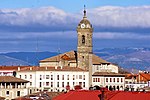Iradier Arena
1941 establishments in SpainBullfighting stubsBullrings in SpainIndoor arenas in SpainSpanish sports venue stubs ... and 3 more
Sports venues completed in 1941Sports venues in the Basque Country (autonomous community)Vitoria-Gasteiz

Iradier Arena, also known as Plaza de Toros de Vitoria-Gasteiz, is an arena and bullring in Vitoria-Gasteiz, Spain. It is primarily used for bullfighting and basketball, and was the home to the Baskonia while the Fernando Buesa Arena was expanded. It opened in 1941 and holds 10,625 spectators.
Excerpt from the Wikipedia article Iradier Arena (License: CC BY-SA 3.0, Authors, Images).Iradier Arena
Berpizkundearen plaza/Plaza del Renacimiento, Vitoria-Gasteiz Babesgabetuak/Desamparados
Geographical coordinates (GPS) Address External links Nearby Places Show on map
Geographical coordinates (GPS)
| Latitude | Longitude |
|---|---|
| N 42.840833333333 ° | E -2.6644444444444 ° |
Address
Iradier Arena
Berpizkundearen plaza/Plaza del Renacimiento 6
01002 Vitoria-Gasteiz, Babesgabetuak/Desamparados
Autonomous Community of the Basque Country, Spain
Open on Google Maps









